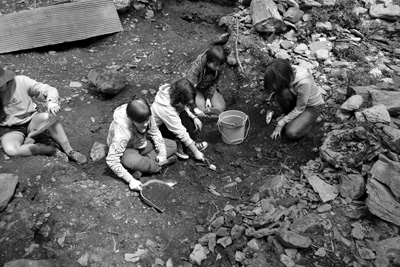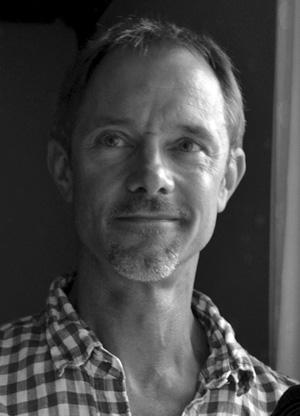News & Issues August 2017
Unearthing a long-lost community
Teacher traces history of Vermont settlement built by Mass. rebels
 By EVAN LAWRENCE
By EVAN LAWRENCE
Contributing writer
SANDGATE, Vt.
High-school students in a summer archaeological field school sift through the soil at a remote property in Sandgate, Vt., where leaders of the Shays Rebellion built an extensive community beginning in 1787. The rebels fled Massachusetts for Vermont, which was then an independent republic. Courtesy photo
In the dense forest of southwestern Vermont, an area schoolteacher has been working with students to unearth a lost settlement created more than 200 years ago by a band of Massachusetts rebels.
Steve Butz, who teaches earth science at Cambridge Central School, just across the state line in New York, says the long-abandoned community in the mountains of Sandgate was built by Daniel Shays and other Revolutionary War veterans who participated in what became known as the Shays Rebellion.
Shays, who had served as a captain in the Continental Army, was among hundreds of farmers who organized a revolt against the Massachusetts government in early 1787 over its tax policies and debt-collection practices. After the rebels failed to seize control of an arsenal in Springfield, Mass., Shays and some other leaders of the uprising fled north to Vermont, which at the time was an independent republic.
 Butz said he first began to learn about the Sandgate settlement when he was teaching at the nearby Salem Central School, where he began his career in 1996. A friend in Salem told him about an abandoned “fort” in the mountains east of the village. The friend took him there by snowmobile, so Butz could see the stone walls and rubble piles for himself.
Butz said he first began to learn about the Sandgate settlement when he was teaching at the nearby Salem Central School, where he began his career in 1996. A friend in Salem told him about an abandoned “fort” in the mountains east of the village. The friend took him there by snowmobile, so Butz could see the stone walls and rubble piles for himself.
“To me, it didn’t make any sense,” Butz said.
Why, he wondered, would people wanted for treason in Massachusetts build a fort in a remote corner of southern Vermont? He was intrigued and started doing research.
Butz soon found the story was part of local lore on both sides of the state line, including 19th century descriptions of “smoke from a hundred cabins” on the mountain being visible from Salem.
“People in Sandgate and Salem knew [Shays] was there and built the fort,” Butz said.
But some people warned Butz to stay away from the site or risk catching “the plague.”
“There was a lot of hearsay, but no formal research,” Butz said.
So he set out to investigate the settlement site. Although Butz wasn’t a professional archaeologist, he had taken courses in the subject and had learned general field techniques, such as mapping and surveying, that would be useful.
Four years ago, he sent a proposal to do an archaeological study to the site’s new owner, The Forestland Group, an independent timberland investment organization. The owner agreed to allow Butz access and provide some funding.
Butz did a GPS survey, following the woods road he had traveled by snowmobile. As he mapped the stone walls snaking through the woods, he discovered rock piles that looked like the remains of other structures. He and some volunteers began clearing away small trees and overgrown vegetation, removing rocks from where they had collapsed into cellar holes, and dug some small test pits.
“I realized there was something there,” Butz said.
It became clear the site had been not just an isolated fort, but an entire village.
Unrest in a new nation
Capt. Daniel Shays didn’t start the rebellion that bears his name, but he quickly emerged as its leader.
Shays was born in 1747 in Hopkinton, Mass. A farmer by trade, he joined the Massachusetts militia when the Revolutionary War broke out in 1775. He distinguished himself at the battles of Bunker Hill, Ticonderoga, Saratoga and Stony Point. After resigning his commission in 1780, he turned to farming in Pelham, Mass.
The war was officially over by 1783, but many of the returning soldiers had received little or no pay, and their farms had suffered while they were away. Some were deeply in debt.
So when the cash-strapped state imposed high taxes and demanded payment in hard currency, the farmers couldn’t comply. State officials took them to court. The courts authorized the seizure of cattle and property to settle debts, and some farmers wound up in debtors’ prisons.
In the late summer of 1786, angry farmers in several Massachusetts towns, calling themselves Regulators, converged on local courts and shut them down. The protests stopped courts in Great Barrington, Concord, Taunton and other towns from proceeding with debt-collection efforts.
That September, Shays took over a protest outside the court in Springfield and kept it from turning violent. But his action marked him as an “incorrigible rebel” in the view of state officials. After the state arrested some of the protest ringleaders in the eastern part of the state, those in western Massachusetts were radicalized.
In January 1787, Shays and others assembled more than 1,000 men and attempted to storm the federal arsenal in Springfield. The state militia fired into their ranks, killing several, and the Regulators scattered. Shays, with the militia on his heels, fled to New Hampshire.
Butz said his research shows Shays and his supporters continued into Vermont, which had declared itself an independent republic in 1777. Vermont had a reputation as a haven for dissenters, but the Regulators’ rebellion was too much even for some Vermonters: The rebels were told they were not welcome in Bennington or Arlington.
Shays crossed into New York and went to Salem, Butz said. The town had been founded in 1761 by emigrants from Pelham, Mass. Shays’ sister was married to a settler there, and he had several acquaintances in town from his days in the Army. They told him land was for sale on a mountain in Sandgate. Shays bought two lots.
Although the Shays Rebellion was crushed in early 1787, the uprising helped set the stage for the drafting the Constitution later that year. At the time, the new nation was bound together only by the Articles of Confederation, drafted in 1776-77, which created a wartime league of states with a very limited central government. There was not yet a president or even a provision for choosing one, and the central government had no taxing power, instead relying on payments from the states.
Delegates to the Constitutional Convention, which began in May, were divided between federalists, who wanted a stronger central government, and anti-federalists who opposed this idea. Some historians say the rebellion in Massachusetts helped to strengthen the hand of the federalists.
Growing in rough terrain
Butz said he suspects Shays’ purchase of land in Sandgate received financial aid from John Bay, a prominent New York lawyer who was also an anti-federalist. Construction of the fort, most likely the first building on the site, probably began in early 1788.
As other refugees from the rebellion joined Shays, the settlement grew. Some sources say it had a tavern, a mill for grinding grain and possibly sawing lumber, a schoolhouse, and 15 to 18 houses around a town green. Butz believes between 100 and 200 people lived there.
Butz started an archaeological field school for high school students in the summer of 2014. To date, they’ve cleared sites for digging and excavated around the mill site, a house with a center chimney that may have been a blacksmith’s forge, and five other foundations. Except for trash from a hunting camp that had been tossed into one cellar hole, the site was undisturbed -- a rarity in this region.
 The excavations have turned up many pieces of pottery from Staffordshire, England, along with metal tools, horse and ox shoes, eating utensils, nails, the bit from a horse’s bridle, animal bones, clay pipes, many bits of window glass, a pair of eyeglasses, and two coins, one a Spanish silver dollar from 1776 and the other a Connecticut copper coin from 1787.
The excavations have turned up many pieces of pottery from Staffordshire, England, along with metal tools, horse and ox shoes, eating utensils, nails, the bit from a horse’s bridle, animal bones, clay pipes, many bits of window glass, a pair of eyeglasses, and two coins, one a Spanish silver dollar from 1776 and the other a Connecticut copper coin from 1787.
Based on their styles, the pottery and clay pipes can be dated quite accurately to 1788-1815, Butz said. The Forestland Group paid for carbon dating of tobacco residue in one of the clay pipes and charred wood around a nail, which gave similar dates.
“Shays definitely lived at the site,” Butz said.
He believes the house closest to Salem, the largest found so far, belonged to Shays, with the other large houses belonging to other leaders of the rebellion. Other followers may have built log cabins that left little trace. Smaller stone piles in the area that haven’t been investigated yet could be chimneys for those structures.
Shays and others accused of leading the rebellion didn’t stay long at the settlement. Shays appealed for a state pardon and received one in June 1788 from Massachusetts’ new governor, John Hancock.
Shays was recorded as a resident of Arlington, Vt., in the census of 1790. He returned briefly to Pelham, then moved to New York state. He eventually settled in Sparta (now Conesus), a community in the Finger Lakes region, where he died in 1825.
But the settlement in the mountains of Sandgate seems to have continued for another 25 years after Shays left.
“It was a good long time for people to live there,” Butz said. Based on materials the excavations have found, such as window glass, “they were not without means.”
But even under the best of conditions, it must have been a difficult place to live. Salem, still the nearest town of any size, is miles away. At an elevation of 2,000 feet, the land is steep and rocky, the soil thin. Water is seasonally abundant in mountain streams, but settlers would have had to clear the forest to create building sites, pastures and cropland.
Butz, who had to clear tumbled rocks out of the cellar holes, is impressed by “the incredible amount of effort to make the structures.”
A sudden demise
The site appears to have been abandoned abruptly in 1815. Local records tell of two epidemics around that time. Butz thinks they could have been typhus or dysentery. The settlement may have lost so many people that any survivors decided to get out.
“All the sites have charcoal layers, which is a suggestion that the buildings were burned,” Butz said.
There is no evidence of forest fires in the area, he added. Most of the artifacts appear to have been in the buildings at the time of the fire. They weren’t broken and tossed away.
“We’re finding perfectly good tools,” Butz said. “Why leave a perfectly good ax?”
The buildings may have been burned to prevent the spread of contagion, Butz said, or the locals may have believed the site was “cursed” because of the Shaysites’ treason.
No human remains have been recovered. But there is a large pile of rocks with one stone set upright at the top. Butz thinks that if an epidemic hit the settlement in winter when the ground was frozen, the survivors may have made a pile of the bodies and covered them with rocks as an improvised mass grave.
The fourth summer field school at the site started at the end of July and continues through mid-August. Ninety-two high students have gone through the program so far, Butz said, mostly from Cambridge Central School but also from Vermont and Massachusetts. The focus of their work this summer will be on the center-chimney house.
Butz has written a book about the settlement, “Shays’ Settlement in Vermont: A Story of Revolt and Archaeology,” which will be published later this month by The History Press. Battenkill Books in Cambridge will hold a book release party on Monday, Aug. 21.
The site and field school were featured on two episodes of “History Where It Happened,” a production of GNAT-TV, the public access cable television station based in Manchester.
Butz thinks the story “has great potential” for treatment in a longer documentary.
“It’s an interesting piece of lost history,” he said.
The more immediate question is what to do with the artifacts Butz and his team are uncovering. For now, some are on display at Cambridge Central School.
“I’d like a partnership with a museum in Vermont,” Butz said. “That’s the next goal to be achieved -- that and long-term site preservation. The work could go on for years.”
The Shays settlement site is on private land and not open to the public. For more information about the site, visit www.shayssettlement.org. Springfield Technical Community College in Springfield, Mass., has a Web page – shaysrebellion.stcc.edu -- devoted to the history of the Shays rebellion.
